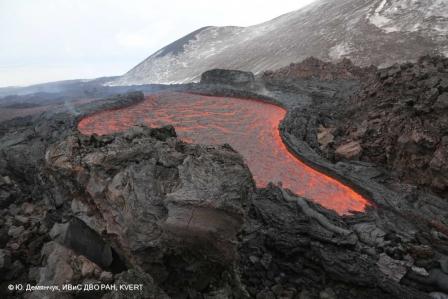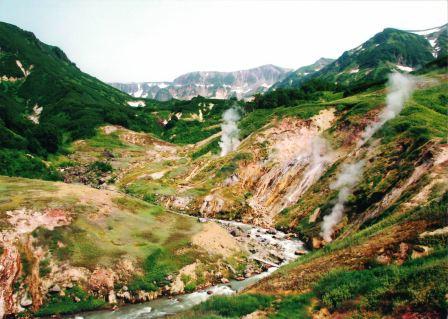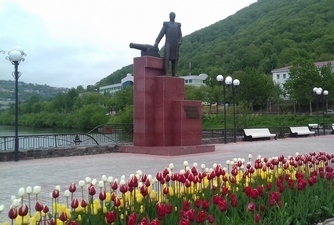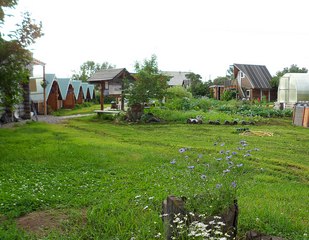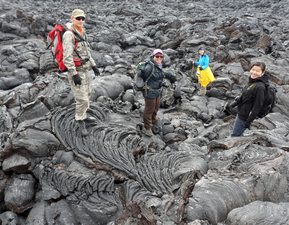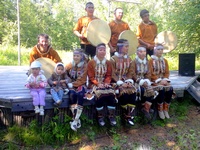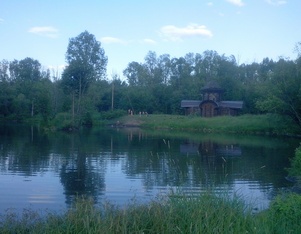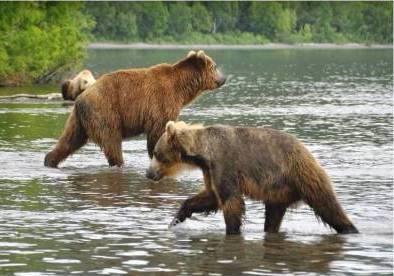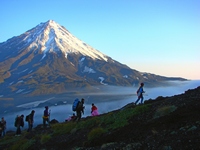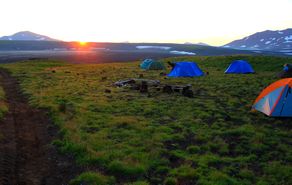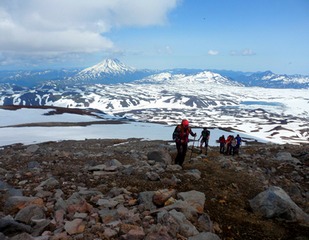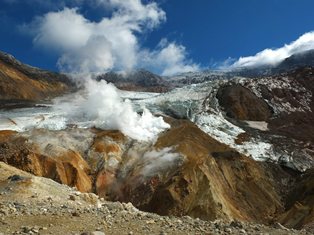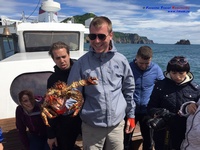Kamchatka's main attractions in 15 days
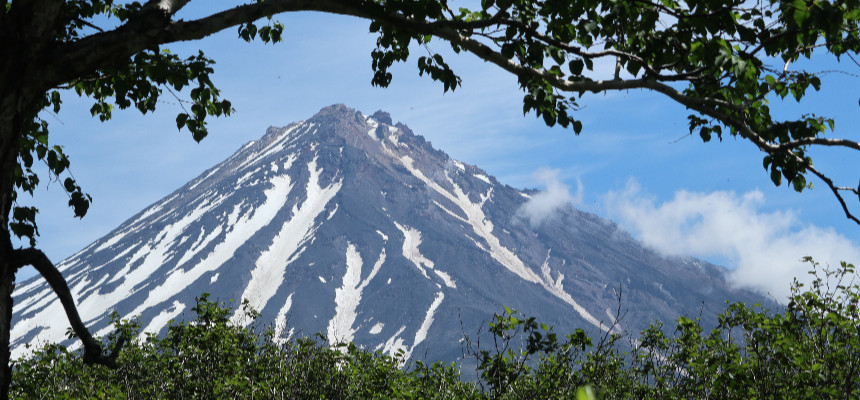
- General information
- Detailed program
- Necessary equipment
- Tour cost
Short description
Route: Petropavlovsk-Kamchatsky - Milkovo settlement - Kozyrevsk village - Tolbachik dale - Plosky Tolbachik volcano - Esso village - Milkovo settlement - Petropavlovsk-Kamchatsky - Kuril lake (on your wish) - Camel Rock - Avachinsky volcano - Petropavlovsk-Kamchatsky - Avacha Bay - Starichkov island - Petropavlovsk-Kamchatsky.
A full-fledged two-weeks' tour will let you visit the main places of interest in Kamchatka you may have already heard about.
The route gives a possibility:
- to reach the craters of four active volcanoes;
- to visit the central part of the peninsula, the so called «Kamchatka Switzerland»;
- to get acquainted with the history of Kamchatka, with the way of living and customs of the indigenous people of Kamchatka and to take part in the traditional rites of Evens – the local nation.
- to take part in a helicopter excursion to Kuril Lake where you'll observe brown bears fishing.
You may also choose some optional excursions:
- sea trip through Avacha bay to Starichkov island;
- sea trip to Russkaya bay where you may go into sea fishing;
- helicopter excursion to the heart of Kamchatka - the famous Valley of Geysers and Uzon caldera;
- rafting down one of the most charming rivers of Kamchatka.
Additional information:
Ostry (Sharp) Tolbachik volcano (3682 m) and Ploskiy (Flat) Tolbachik volcano (3085 м) – two stratovolcanoes of Klyuchevskaya volcano group.
Great fissure volcanic eruptions (when the volume of lava, ashes and scoria exeeds1 km3) – is a rare natural event. They occur when magma flows up through cracks in the ground. Fissure eruptions are characterized by a curtain of fire, and by lava spewing out to a small height above the ground. Fissure eruptions can produce very heavy flows, though the lava is generally slow moving. In the historical period such great fissure eruptions were registered only seven times: twice in Iceland in 930 and 1783; twice in Mexico in 1759 and 1943; once on Canary Islands in 1730. The sixth and the seventh eruptions occures in Kamchatka in 1975 – 1976 and 2012 – 2013 in Tolbachik Dale.
The Great Tolbachik Fissure Eruption (GTFE) bagan in July 1975 and continued till December 1976 and was the most voluminous eruption of basaltic lava and tephra since the 1783-84 Iceland eruption. About 2 cubic kilometers of material (more than four times the volume of the largest historic eruption of Mauna Loa) were erupted from two major vent areas in the Tolbachik regional zone of cinder cones, a fissure system extending more than 38 kilometers south-southwest of Ploskiy Tolbachik volcano. It resulted in the appearance of the so called Nothern and Southern breakthroughs. Activity at the Northern breakthrough was unusually violent for a basaltic eruption, generating a tephra-laden column 8 to 13 kilometers high that persisted throughout the development of three large cinder cones 330 m., 300 m. and 150 m. high as well as voluminous flows. In 17 months the landscape of Tolbachik Dale changed drastically: the vegetation was destroyed, rivers and lakes were covered by ash. It converted an area of about 400 km2 into a lifeless desert.
According to seismic data on November 27, 2012 Tolbachik Fissure Eruption started. The eruption was named as "The Institute of Volcanology and Seismology 50th Anniversary Fissure Tolbachik Eruption" (FTE-50). It lasted almost 11 months until December 2013. В результате излияния лавовых потоков и стромболианской активности заметно изменился ландшафт Толбачинского дола — появились целые поля, представляющие собой нагромождения лавы высотой до 15 метров, продолжающие наращиваться за счёт новых прорывов. The eruption started from two vents, named after eminent Russian volcanologists - Menyailov and Naboko vents, and after three days all activity concentrated in the lower (Naboko) vent. Three new lava fields were formed with a total area is about 36 km2. Two scientific bases had been destroyed by lava flows. The road to Tolbachinsky Dol was blocked..
The Valley of Geisers – is one of the largest geyser areas in the world and the only one in Eurasia. It is situated in the heart of the Kronotskiy Preserve. Geysers are definitely nature miracles, because there are only four large fields sheltering dozens of natural fountains, staggering by their striking beauty and unique periodicity of work! Not far from the Valley there’s the caldera of the ancient Uzon volcano, that attracts tourists from all over the world. The caldera of the Uzon volcano is a volcanic depression, which was formed in the result of the volcano top collapse.
If this tour is too long for you or you'd like to organize your accommodation yourself, we offer you to look through the shorter variant of the program. We also recommend you to take a look at a prolonged - fifteen days' tour.
Day 1: Arrival in Kamchatka
Arrival in Petropavlovsk-Kamchatsky. Meeting at the airport. Transfer to the hotel and check-in. Lunch at the hotel. A brief city-tour around Petropavlovsk-Kamchatsky (drive to the viewing point and some historical sites of the town).
The city, founded by Danish navigator Vitus Bering in 1740, has always been a strategic port in the Far East of Russia. Many round-the-world expeditions of the XVIII – XIX centuries visited Petropavlovsk-Kamchatsky with the refreshment purposes. During the 1854–1855 Crimean War the city was put under siege by the Anglo-French forces but never fell.
On return to the hotel you meet with the guide to discuss the program in detail.
Dinner at the hotel. Overnight stay at the hotel.
Day 2: PKC – Kozyrevsk
Breakfast. Transfer by all-terrain bus to Kozyrevsk village, on the bank of the river Kamchatka. Lunch en route in the old Cossaсk settlement Milkovo. Arrival at the village of Kozyrevsk. Accommodation at a private hotel, in wooden houses on a specially prepared ground.
Kozyrevsk is one of the oldest settlements of the Kamchatka region. It was founded in the 18-th century on the site of an ancient village of Itelmen – the indigenous inhabitants of the peninsula. It is situated in the valley of the river Kamchatka, 492 km to the north of Petropavlovsk-Kamchatsky. It is also only 37 – 48 km away to the west of the active volcanoes: Ushkovsky (3943 m), Besymyanny (2882 m) and the highest active volcano of Europe and Asia – Klyuchevskaya Sopka (4850 m). A big Neolithic site – the remains of earth-houses, about 800 years of age, was discovered by archeologists in immediate proximity to Kozyrevsk.
Walking excursion around the village. Typical Russian sauna (banya).
Dinner. Instructions for the next day. Overnight stay in wooden huts on a specially prepared ground.
Day 3: Kozyrevsk – Tolbachik valley – the spot of The Great Tolbachik Fissure Eruption of 1975 – 1976
Breakfast. We drive to Tolbachik dale to the height of about 1200 m asl. Excursion to the slag cones of the Northern explosion that appeared during the Great Tolbachik Fissure Eruption in 1975 – 1976. Climbing a new volcanic cone.
The new cones look like mini-volcanoes up to 200 meters high.
Lunch. Excursion to the "Dead Forest" and exploration of the old lava caves in the crater of the cone Zvezda (The Star). Transfer to the site of the base camp.
Assembling the tents. Dinner. Instructions for the next day.
Overnight in tents in the camp.
Day 4: Ascent to Flat Tolbachik volcano (3085 m)
Breakfast. Ascent to the top of Plosky (Flat) Tolbachik volcano (3085 m asl.). You will be en route 10 to 12 hours. Lunch on the volcano slope.
As a result of The Great Tolbachik Fissure Eruption the bottom of the crater was destroyed and a 500 meters deep caldera was formed. It is now 1,7 km wide.
Observe the crater and the surrounding landscape.
Return to the base camp. Dinner. Instructions for the next day.
Overnight stay in tents in the base camp.
Day 5: The Tolbachik fissure eruption of 2012 – 2013
Breakfast. Walking excursion to Menyailov’s crater and the eruptive fissure – the central spot of the eruption of 2012 – 2013 (which was given the name of 50-th anniversary of the Institute of volcanology and seismology FED RAS). Exploration of the site: large fresh lava flows, caves (lava tubes), stone sculptures and piles upon piles of the frozen lava.
When studying the aftereffects of the eruption of the year 2013 the scientists discovered diamonds, that were formed as a result of the synthesis of carbonic gasses.
Lunch en route.
Return to the base camp. Dinner. Instructions for the next day.
Overnight stay in tents in the base camp.
Day 6: Tolbachik valley – "Menedeck" – Esso
Breakfast. Packing up the camp. Transfer to the village of Esso.
The way from the camp to Esso is 160 km long in a cross country which will take us about 5 hours.
On the way to Esso we take a break in a small ethnographical village of Evens – Kamchatka indigenous people. They will tell you about their way of living and customs. Lunch in the national village.
Arrival in Esso.
Check-in at the hotel with a thermal swimming pool. Dinner.
Overnight stay at the hotel.
Day 7: Esso – PKC
Breakfast. Drive to Petropavlovsk-Kamchatsky.
Lunch en route in the settlement of Milkovo.
Arrival at Petropavlovsk-Kamchatsky.
Check-in at the hotel. Dinner.
Overnight stay at the hotel.
Day 8: PKC - Kuril Lake - PKC
Breakfast. Transfer to the helipad.
Helicopter flight to Kuril Lake. Flight time about 1 hour.
Arrival at the lake. Trekking excursion on the lake. Bears and salmon spawning viewing. Trek to fish-counting weir.
Lunch: salmon with rise, tea/сoffee, juice. Duration of the excursion is 1 hour 30 minutes.
Flight (15 minutes) to the next stop - the caldera of Ksudach volcano.
Trekking excursion in the caldera. Hot Beach viewing. Duration of the excursion is 15 - 20 minutes.
Caldera of Ksudach volcano is the Monument of Nature due to its geological construction. The eruption resulting in the volcano collapse took place in 1907 so that its volcanic ash is still recognized 200 km away from the epicenter of eruption.
Flight to the next stop - about 20 minutes. Landing at the foot of Khodutka volcano. Bathing in the unique hot river, where temperature of water reaches 40°С.
The springs are believed to have a healing effect as they contain a great amount of silicic acid.
Flight back to town. Flight time is about 40 minutes.
Transfer to the hotel. Dinner. Overnight stay at the hotel.
If you’d like to abstain from the helicopter excursion you spend this day on your wish. An optional program may be organized for additional fee.
Day 9: PKC – Avachinsky volcano – mount Camel
Breakfast. Transfer by all-terrain bus to the foot of Avachinsky volcano to the altitude of 860 m asl.
Part of the route is through the bed of a dry river. The drive to the distance of 30 km takes 2 – 2,5 hours depending on the road conditions.
Accommodation in huts for 4 – 10 persons in the base camp or in double tents in a tent camp. Walking excursion to the mountain Camel (1200 m asl.) will take us 3 – 4 hours. Lunch en route.
The natural monument – "Mountain Verblyud" (Camel) located on the mountain pass between the volcanoes Avachinsky and Koryaksky – is a small rocky massif with two sharp peaks. The mountain was formed during the eruptions of both volcanoes. As a result of earth crust movement and activity of the volcanoes incandescent lava flowed that later became the mount Verblyud.
Return to the camp. Dinner. Toolbox talk for the next day. Overnight stay in the base camp.
Day 10: Ascent of Avachinsky volcano (2741 m)
Breakfast. Ascent of Avachinsky volcano.
We get to the summit along the western slope by the ascending path with the level of difficulty 1A. The ascent to Avachinsky volcano and return to the base camp take as a rule 9 - 12 hours depending of the participants’ physical fitness. The difference of the altitude is almost 1900 m. The most difficult part of the ascent is the last 100 m.
If you feel en route that you are not ready to continue the ascent, our guide’s assistant will take you back to the camp where you may wait for the rest of the group to return.
Lunch on the volcano slope at the altitude of about 2000 m. Climb the young volcanic cinder cone to the crater. Walk around the crater.
From the edge of the crater you will catch the beautiful view of Nalychevo valley, the southern volcanic group and the Pacific coast. Here you may approach the fumaroles and touch the lava cork that sealed up the crater in 1991.
Descent back to the base camp. Dinner. Toolbox talk for the next day. Overnight stay in the base camp.
Day 11: PKC - the foot of Gorely volcano
Breakfast. Transfer by all-terrain bus to the foot of Vilyuchinsky volcano. The route goes south gaining height along the valley of the river Paratunka.
As we go up the road we stop to make photos and video at the height of 1100 m at Vilyuchinsky pass. There you will get a formidable view of the valley of the river Paratunka and the volcanoes Gorely and Mutnovsky. Then we go south along a volcanic plateau.
Arrival at the destination. Assembling the tents and setting up camp at the stream Spokoyny.
Dinner. Toolbox talk for the next day. Overnight in tents in the camp.
Day 12: Gorely volcano climbing
Breakfast. Transfer to the caldera of Gorely volcano. If it is possible we drive directly to the volcano slope, in case it is not possible due to the snow conditions, we cross the caldera on foot.
Ascent to the crater and to the volcano summit (1829 m a.s.l.).
If you feel en route that you are not ready to continue the ascent, our guide’s assistant will take you back to the camp where you may wait for the rest of the group to return.
Lunch at the top of the volcano. Walk around the craters.
By favourable weather you will see more then 15 volcanoes around. They are Zhirovskoy, Mutnovsky, Vilyuchinsky, Asacha, Opala, Khodutka, Zeltovsky, Aag, Arick, Koryaksky, Avachinsky, Dzendzur, Zhupanovskie and others.
Descent back to the camp. Dinner. Toolbox talk for the next day. Overnight in tents in the camp.
Day 13: Mutnovsky volcano climbing - PKC
Breakfast. Packing up the camp. Transfer by all-terrain bus to the foot of the volcano Mutnovsky. Safety measures instructions. Hiking inside the active crater of the volcano.
The biggest of the craters of the volcano is located at the altitude of 1600 m, it is considered to be one of the most impressive crates in Kamchatka.
Observe the fumarole zone and of the falling glacier. Lunch inside the crater. Return to the automobile.
As a rule it takes 1,5 - 2 hours to get back.
Arrival at the bus. Drive to the canyon Opasny, where you can take pictures of an 80-meters waterfall. Drive back to the town. Accommodation at the hotel. Dinner. Overnight stay at the hotel.
Day 14: Free day for optional excursions
Breakfast at the hotel.
This day you may take part in optional excursions (discussed and payed in advance):
- helicopter excursion to the Valley of Geysers;
- sea trip to Russkaya bay;
- sea trip to Starichkov island;
- rafting down the river Bystraya (Malkinskaya).
Dinner. Overnight stay at the hotel.
Day 15: Departure from Kamchatka
Breakfast. Visit to the local fish market and a gift shop. Transfer to the airport.
- backpack for your personal staff;
- comfortable trekking shoes / trekking boots with high tops;
- gaiters;
- light shoes to change;
- warm hat;
- gloves;
- windproof (fleece) jacket;
- waterproof jacket or raincoat;
- sleeping bag;
- trekking poles (if necessary);
- sunglasses, sunburn treatment cream;
- personal hygiene products, towel;
- bathing suit;
- mosquito spray;
- individual medical kit;
- head torch.
Cost of the tour for the year 2021 is 206.000 roubles or 2.850 Euro per person.
* The tour price includes:
- tourist voucher to apply for visa;
- FSB coordination;
- transport services according to the program;
- hotel accommodation in twin rooms according to the program;
- sea trip;
- fishing licenses;
- fishing-tackle for sea and river fishing;
- accompaniment (guiding services);
- interpreter services (English, German or French-speaking guide);
- services of a cook;
- meals at the hotel and en route;
- provision with tents and sleeping pads;
- use of all group tourist equipment and inventory;
- bathing in thermal springs;
- visit to the national village of Evens;
- recreational services of the nature parks of Kamchatka;
- accident insurance.
* NOT included in the price are:
- air tickets to Petropavlovsk-Kamchatsky and back;
- Helicopter excursion to The Valley of Geysers or Helicopter excursion to Kuril Lake (Are paid additionally. The cost of the excursions for the year 2021 is 46.000 Rub.);
- alcoholic beverages;
- provision with sleepeing bags.
* The price of the tour may vary depending on your wishes and the type of accommodation!




